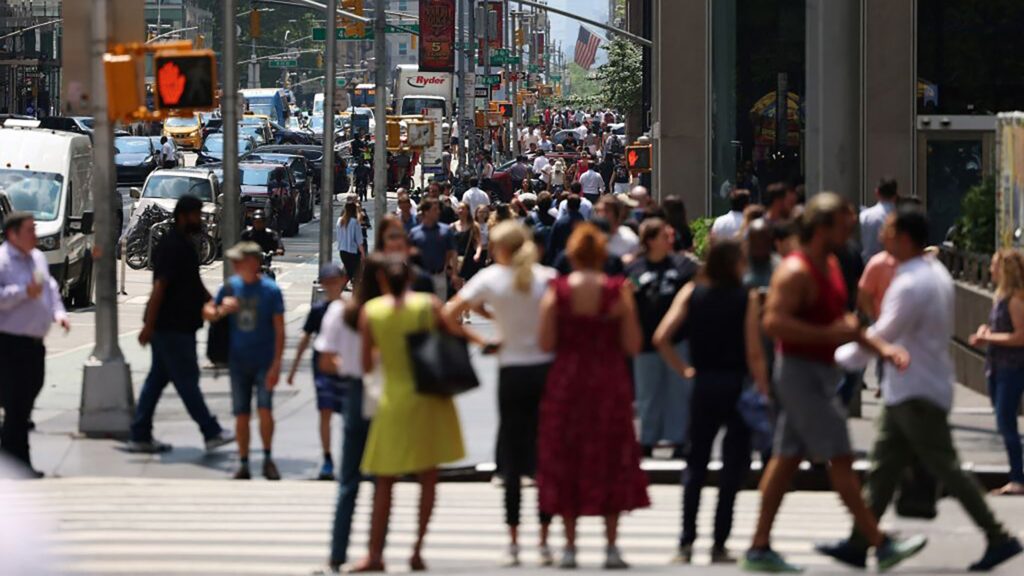A new study illustrates how a city’s specific infrastructure contributes to its inhabitants’ overall health and wellbeing
Get out and walk everybody (Photo: CHARLY TRIBALLEAU/AFP via Getty Images)
Published August 18, 2025 02:24PM
Research is increasingly showing that walking—yes, simple walking—offers a staggering array of health benefits. But what makes us walk more or less? According to a study published last week in the scientific journal Nature, where we live plays an enormous role.
The study, which analyzed smartphone data from over two million people living in 1,600 cities and towns across the United States, suggests that not only do healthy, active people choose to live in walkable cities, but that simply living in a walkable city can actually encourage someone to start walking more.
“Eight years ago, we published a study using smartphone data to understand people’s activity globally,” behavioral scientist Tim Althoff, a University of Washington professor and co-author of the study, shared on LinkedIn. Althoff explained that this initial study, published in 2017, which looked at 111 different countries, was intended to “measure physical activity at the global scale.”
Walkability is way that urban planners measure a city’s amenities for pedestrians: sidewalks, crosswalks, footpaths, walking flyovers, and other ways for people to move about on foot.
The study did find major discrepancies in physical activity between various countries and cities, but it still left big questions unanswered. Chiefly, “is it the city that makes people walk more, or do active people just choose to live there?”
To answer this nagging question, Althoff and his colleagues, which also included researchers from Stanford University and tech firm NVIDIA, examined the lifestyle changes made by people moving from more walkable cities to less walkable ones, and vice versa. They looked at smartphone data from a total of 2,112,288 people, measuring their physical activity both before and after 7,447 relocations between 1,609 different cities in the U.S.
The result? If you move to a city with robust pedestrian infrastructure—New York City, for example—you’ll probably start walking more, and the same is true in reverse. “People who moved from a less walkable city to a more walkable one increased their walking by ~1,100 steps a day, on average,” Althoff explained, adding that the effect goes both ways. “People moving to NYC from less walkable places gained ~1,400 steps. People who moved away from NYC lost ~1,400 steps.”
While at first glance, the study results might be explained simply by the fact that more active people are more likely to choose to move to more walkable cities, the researchers noticed that people who moved between two different cities with similar levels of walkability had no measurable change in walking habits. This suggests that not just personal preferences, but the “built environment” (i.e. the layout and planning of a city), plays a considerable role in the walking habits of a given individual.
The research shows that these lifestyle changes “hold across different genders, ages and body mass index values,” and all were sustained over at least three months. The new walking was also mostly “moderate-to-vigorous,” which is a good thing, because that’s the level of aerobic exercise recommended by doctors to prevent disease and improve longevity. Althoff said that “moving to a much more walkable city nearly doubled the chances that a person would meet the national guidelines for physical activity,” (150 minutes of moderate-to-vigorous activity per week).
At the policy level, the big finding, said Althoff, is that “city planning is a powerful public health tool” and investment in sidewalks, crosswalks, pedestrian signals, parks and plazas, isn’t just a way to make a city more appealing to those who already live an active lifestyle, but a way to encourage existing inhabitants to live a more active one, too. Many of us don’t have the financial means to pick up and move to a more walkable city, of course, but Althoff and his colleagues’ findings make a strong case for advocating for more pedestrian-friendly infrastructure in your own city or town.


